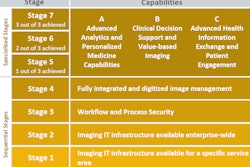
Teleradiology has become widely adopted in Europe, but its usage and support vary among European countries, according to a pair of surveys by the European Society of Radiology (ESR). What's more, the use of teleradiology across national borders still remains limited.
The ESR separately surveyed European national radiology societies as well as ESR radiologist members and found that teleradiology was commonly used both within hospital networks and for outsourcing purposes. Most national societies did not report a positive effect from teleradiology outsourcing, while ESR radiologist members had varying opinions on the threat teleradiology poses to radiologists, according to a report published online May 17 in Insights into Imaging.
"It is, however, clear that the general reluctance toward use of teleradiology comes from fear of deteriorating hospital-based radiology and a commoditization of low-cost external services," concluded the report by the ESR's eHealth and Informatics Subcommittee.
European teleradiology use
Teleradiology is increasingly being adopted in Europe, thanks to the development of new technical infrastructures and networks that facilitate faster image transfer. However, national radiology societies have different views on teleradiology, with some expressing significant concern over the current and future use of the technology, according to the ESR.
"This particularly relates to outsourcing, and the effects that this might have on the quality and delivery of radiological services," the authors wrote.
To get a better sense of these differences and ascertain the current state of teleradiology adoption in Europe, the ESR's eHealth and Informatics Subcommittee worked with the society's Quality, Safety, and Standards Committee to develop two online surveys.
National societies were sent a survey that assessed the different impact of insourcing (teleradiology performed between sites to enable radiologists to work offsite or report images from remote locations) and outsourcing (imaging worklists are sent to teleradiology companies), according to the ESR. This survey included 11 questions and a section for free-text comments. Of the 44 national societies, 25 (56.8%) completed the survey.
| National society responses on teleradiology | ||
| Teleradiology for insourcing | Teleradiology for outsourcing | |
| Used by their country | 74% | 70.8% |
| Used for fewer than 5% of reports | 56% | 41.7% |
| Used for up to 25% of reports | 32% | 20.8% |
| Used as part of daytime service | 44% | 41.7% |
| Used for nighthawk service | 52% | 50% |
| Has had a positive effect on service | 60% | 16.7% |
| Has not had a positive effect | 12% | 33.3% |
In other findings, 70.8% of national societies said that outsourcing was not generally supported by their organization; 29.2% said that outsourcing was generally supported.
"Despite positive effects on workload and quicker turnaround times, outsourcing in particular is associated with significant concerns such as quality, legal issues, and reducing the clinical role of radiologists," the authors wrote.
Wide adoption of teleradiology
The second survey was sent to ESR radiologist members. Consisting of 34 questions and a free-text response section, this survey queried radiologists on areas such as the impact and practice of teleradiology services, the financial aspects of teleradiology, guidelines and legislation, and an evaluation of teleradiology in general.
The ESR received responses to the second survey from 568 full radiologist members. Most (68.3%) indicated that they used teleradiology (for insourcing or outsourcing), while 31.7% said they did not use teleradiology.
The 51.7% of members who used teleradiology for outsourcing utilized it in a variety of ways:
- Readings are outsourced from backlog: 27.6%
- On-call readings are outsourced during nights and weekends: 23.4%
- Specialized readings are outsourced due to a lack of experience: 6.8%
Applications also varied for the 32.5% who used teleradiology insourcing at their organizations:
- For expert/subspecialty readings: 26.5%
- For on-call purposes: 21.5%
- Worklists are shared between private hospitals within the same hospital group: 13.8%
"The results of this survey confirm a relatively wide adoption of teleradiology in Europe with a variable focus on what is the real application in clinical practice," they wrote.
However, the survey also found limited use of cross-border teleradiology in Europe. Of the respondents, 55.3% said that all offsite radiologists need to be located in the country where the examination is performed; therefore, they did not work with international teleradiology for final readings, according to the report.
Interestingly, 17.8% said they did not know whether they worked with international teleradiology for final readings. An additional 10% indicated that images could be read from another country by a radiologist registered in the country where the exam was performed, while 7.8% said this could be done only for "expert/research/scientific" purposes. Only 2.4% said that images could be read from another country by radiologists registered in a non-EU state.
"Differences between global EU legislation and local and national regulations may result in contradictions that can be confusing," the authors wrote. "The lack of awareness of the radiology community about these regulations may also be a source of inadequate apprehension of the fundamental guidelines in adopting teleradiology in clinical practice."
The threat of teleradiology
Opinions also varied about the potential risks of teleradiology:
- Teleradiology is no threat for private/hospital-based radiologists: 34.9%
- Teleradiology devalues the radiology profession to a "commodity" that can be replaced: 30.9%
- Hospitals still prefer local radiologists for better services, although they could have savings with outsourcing: 27.6%
- Hospital managers are threatening radiologists with outsourcing and increasing the pressure on local radiologists: 20.7%
- Commercial/private teleradiology providers are trying to replace local radiologists: 18.8%
- Younger radiologists will find fewer jobs in hospitals due to teleradiology services: 13.8%
- Do not know if teleradiology is a possible threat to local onsite radiologists: 7.6%
The ESR said the lack of awareness regarding teleradiology quality assurance was striking: 36.3% of respondents said they did not know how teleradiology quality assurance was performed at their organization.
The report's authors also noted that 52.2% of respondents said that patients do not know that teleradiology is being used for outsourcing. In addition, 71.9% of respondents said they did not know in their working environment if patients are satisfied with teleradiology.
"Perhaps more attention should be paid to the patient's point of view regarding usage of teleradiology, especially in the context of the current patient-centered trend in healthcare," they wrote.



















